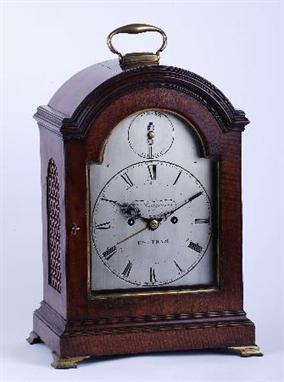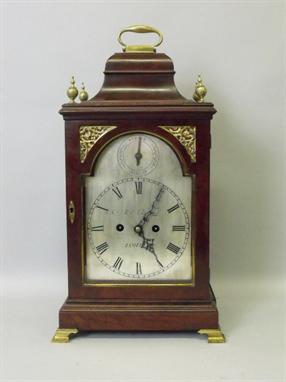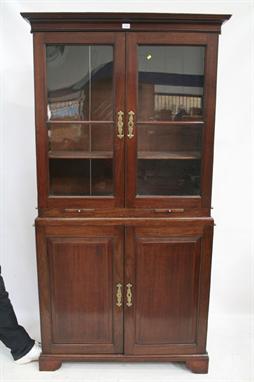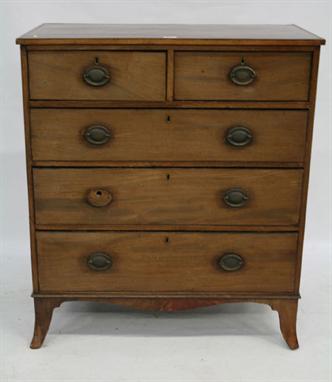A brass `falling ball` wall timepiece Thwaites and Reed, London, dated 1972 The brass sphere engraved as a terrestrial globe with rotating silvered Roman numeral annular chapter ring against pointer to give the time, enclosing a movement with platform lever escapement driven by the weight of the timepiece as it descends against a pulley wrapped with a steel ribbon suspension line, the whole suspended from an elaborate scroll cast brass bracket signed Thwaites & Reed and mounted onto a lozenge shaped mahogany backboard further conforming cast brass plaque inscribed for the original owner M.J. WEBB, 1972, (steel ribbon line snapped), diameter of globe13cm, the mahogany backboard 66cm (26ins) high. THIS DESCRIPTION TO BE READ IN CONJUNCTION WITH ‘IMPORTANT NOTES REGARDING THE CATALOGUING OF CLOCKS’ PRINTED IN THE SALE CATALOGUE OR AVAILABLE FROM THE SALEROOM ON REQUEST. This timepiece is one of limited edition of five hundred examples made to order by Thwaites and Reed offered exclusively to members of the Diners club in 1972.
177692 Preisdatenbank Los(e) gefunden, die Ihrer Suche entsprechen
177692 Lose gefunden, die zu Ihrer Suche passen. Abonnieren Sie die Preisdatenbank, um sofortigen Zugriff auf alle Dienstleistungen der Preisdatenbank zu haben.
Preisdatenbank abonnieren- Liste
- Galerie
-
177692 Los(e)/Seite
A Regency mahogany eight-day longcase clock Jullion, Brentford, early 19th century The five-pillar rack and bell striking movement with 12 inch single-sheet silvered brass Roman numeral circular dial with calendar aperture beneath signature JULLION BRENTFORD to centre and Arabic five minutes to outer track, the case with wavy edge crest to the break-arch pediment above cast brass circular bezel with ebony line infill to lower quadrants flanked by applied split pilasters to hood and circular sound frets to sides, the trunk with break-arch door above shaped-panel decorated plinth base with skirt incorporating bracket feet with shaped apron between, 206cm (6ft 9ins) high. THIS DESCRIPTION TO BE READ IN CONJUNCTION WITH ‘IMPORTANT NOTES REGARDING THE CATALOGUING OF CLOCKS’ PRINTED IN THE SALE CATALOGUE OR AVAILABLE FROM THE SALEROOM ON REQUEST. Probably by Jullian, John and Son, who are recorded in Baillie, G.H.Watchmakers & Clockmakers of the World as working in New Brentford from 1762.
A George III mahogany bracket clock Francis Holland, London for W. Hargraves, Bentham, circa 1805 The five pillar twin chain-fusee bell striking movement with half-deadbeat escapement and signed Francis Holland, LONDON within swag draped oval reserve to upper half of the foliate engraved backplate, the large lenticular-bob pendulum engraved with a bird within conforming arcaded border, the 7 inch single-sheet silvered brass Roman numeral break-arch dial inscribed W: Hargraves BENTHAM to centre, with brass third hand for the sweep calendar inner track, the narrow outer track divided for minutes, the arch with STRIKE/SILENT dial, in a break-arch case with hinged brass carrying handle above brass fishscale break-arch sound frets to sides, on moulded base with brass ogee bracket feet, 41cm (16ins) high excluding handle. THIS DESCRIPTION TO BE READ IN CONJUNCTION WITH ‘IMPORTANT NOTES REGARDING THE CATALOGUING OF CLOCKS’ PRINTED IN THE SALE CATALOGUE OR AVAILABLE FROM THE SALEROOM ON REQUEST. Provenance: property of a gentleman, purchased in Arlesford, Hampshire approximately forty five years ago. Francis Holland is recorded in Baillie, G.H. Watchmakers & Clockmakers of the World as working in London 1802-8. This clock was probably supplied to W. Hargraves of Bentham for retail. Although W. Hargraves appears to be unrecorded working from Bentham at this time he is probably related to one or more of the several makers with the same surname recorded working from locations nearby throughout the 19th century.
A Victorian mahogany bracket clock Drescher & Co., Hull, mid 19th century The four pillar twin fusee bell striking movement with anchor escapement and shouldered plates, the 8 inch circular white painted Roman numeral dial signed DRESCHER, & Co., HULL to centre, the case with scroll carved crest fronting the shaped pediment above bevel-glazed rectangular side windows and cast brass bezel with further foliate carved decoration to apron, on moulded plinth base with compressed bun feet, 45cm (15ins) high. THIS DESCRIPTION TO BE READ IN CONJUNCTION WITH ‘IMPORTANT NOTES REGARDING THE CATALOGUING OF CLOCKS’ PRINTED IN THE SALE CATALOGUE OR AVAILABLE FROM THE SALEROOM ON REQUEST. Two makers with the surname Drescher (John and Pius) are recorded in Loomes, Brian Watchmakers & Clockmakers of the World Volume 2 as working in Hull up to 1858, this clock may be by either of these makers successors.
An inlaid oak thirty-hour longcase clock with Adam and Eve automaton Richard Blakeborough, Otley, early 19th century The plated countwheel bell striking movement with 14 inch white painted Roman numeral break-arch dial with arched calendar aperture and signed R. Blakeborough, Otley and numbered 1939 to centre, within chapter ring with Arabic fifteen minutes to outer track and floral spray decorated spandrels beneath arch with recessed painted scene of the Garden of Eden applied with figures of Adam and Eve each gesturing with the motion of the pendulum towards a central tree entwined with the serpent, in a swan neck pedimented case with turned pilasters to hood above oval fan cartouche centred shaped-top short trunk door flanked by line decorated canted angles, on conforming crossbanded panel inlaid plinth base with bracket front feet, 228cm (7ft 6ins) high. THIS DESCRIPTION TO BE READ IN CONJUNCTION WITH ‘IMPORTANT NOTES REGARDING THE CATALOGUING OF CLOCKS’ PRINTED IN THE SALE CATALOGUE OR AVAILABLE FROM THE SALEROOM ON REQUEST. Richard Blakeborough is recorded in Loomes, Brian, Watchmakers & Clockmakers of The World Volume 2 as working in Pately Bridge up to 1817 then in Otley 1817-39.
A George III oak thirty-hour longcase clock James Gregory, Lasham, circa 1770 The plated pinned-countwheel bell striking movement with 10 inch square brass two-handed dial signed James Gregory, Lasham to the Ho-Ho bird and foliate swag engraved centre within an applied narrow Roman numeral chapter ring with Arabic five minutes and rococo scroll cast spandrels to angles, the case with cavetto cornice and plain frieze above integral pillars to hood, with rectangular door to trunk and on plinth base with bracket feet, 200cm (6ft 7ins) high. THIS DESCRIPTION TO BE READ IN CONJUNCTION WITH ‘IMPORTANT NOTES REGARDING THE CATALOGUING OF CLOCKS’ PRINTED IN THE SALE CATALOGUE OR AVAILABLE FROM THE SALEROOM ON REQUEST.
A George III mahogany miniature lantern clock case Late 18th century With shaped outline triangular broken pediment fronted crest above moulded cornice and front door with aperture for 4.5 inch break-arch dial (height of aperture 6.5inches), the sides continuing down to form scroll pierced bracket supports to underside, 45cm (17.5ins) high overall. THIS DESCRIPTION TO BE READ IN CONJUNCTION WITH ‘IMPORTANT NOTES REGARDING THE CATALOGUING OF CLOCKS’ PRINTED IN THE SALE CATALOGUE OR AVAILABLE FROM THE SALEROOM ON REQUEST.
A fine and rare William III small ebonised thirty-hour longcase clock Samuel Aldworth, Oxford, circa 1690 The five finned pillar outside countwheel bell striking movement with Knibb-type pendulum suspension incorporating butterfly nut pendulum regulation, separate shaped cock for the pallet arbor and pallet shaped aperture in the backplate, the 9.75 inch square brass dial with finely pierced and worked blacked steel hands and finely matted centre within applied silvered Roman numeral chapter ring with stylised fleur-de-lys half hour markers and Arabic five minutes within the outer track, the angles applied with cherub head and foliate scroll cast spandrels, the dial plate signed Sam. Aldworth Oxonia fecit to lower edge, the case with ogee moulded cornice above original Knibb type fret and twist turned integral pilasters to the originally rising hood, the trunk with remnants of the original movement securing bracket and raised hood retention catch to backboard, the convex moulded throat with original heart-shaped spoon catch for locking the rising hood above 43 inch trunk door inset with an oval lenticle, on plinth base with moulded skirt (case with repair to trunk door and consolidation to exterior of base), 198cm (6ft 6ins) high. THIS DESCRIPTION TO BE READ IN CONJUNCTION WITH ‘IMPORTANT NOTES REGARDING THE CATALOGUING OF CLOCKS’ PRINTED IN THE SALE CATALOGUE OR AVAILABLE FROM THE SALEROOM ON REQUEST. Provenance: Part of a private collection, Gloucestershire, acquired between the wars thence by descent. Samuel Aldworth was apprenticed to John Knibb of Oxford in 1673 shortly after John had taken over the Oxford business of his brother Joseph, who had left for London in 1671. After completing his apprenticeship in 1680, Aldworth continued to work in the same workshop as journeyman until 1689 when he left to set up on his own. In 1697 he moved to London (the same year that Joseph Knibb retired to Hanslop) setting up business in the Strand. In 1703 he married Elizabeth Knibb (thought to be daughter of John) and by 1720 he had moved to Childrey, Oxfordshire. The current lot would have been one of the first clocks made by Aldworth after he had left the workshop of John Knibb to set up on his own in 1689. Features such as the pendulum suspension, separately cocked pallet arbor and butterfly nut regulation adjustment demonstrate a direct influence from his master. The dial is also closely comparable to those found on longcase clocks originating from Knibb, and the case was almost certainly supplied by his casemaker.
An ebony veneered basket topped bracket clock Dial and case late 17th century, the movement later Now with four pillar twin fusee bell striking movement with anchor escapement and pendulum holdfast to backplate, the 7 inch square brass dial with ringed winding holes and border-engraved calendar and false bob apertures to the matted centre, within an applied silvered brass Roman numeral chapter ring with stylised sword hilt half hour markers and bearing signature Wm. Westbrook, London to lower margin with Arabic five minutes to outer track and winged cherub head cast spandrels to angles, the case with scroll-cast handle above elaborate foliate pierced brass basket top centred with a panel with St. George slaying the dragon to front and with ball-and-spire finials to corners, the sides with rectangular side windows, on moulded base with brass ball feet, the rear door applied with paper label inscribed Miss Sheffield, 37cm (14.5ins) high excluding handle. THIS DESCRIPTION TO BE READ IN CONJUNCTION WITH ‘IMPORTANT NOTES REGARDING THE CATALOGUING OF CLOCKS’ PRINTED IN THE SALE CATALOGUE OR AVAILABLE FROM THE SALEROOM ON REQUEST. Provenance: The property of Viscount Portman, Spencer House thence by descent to The Late Henry Clive and Mrs. Clive, formerly of Perrystone Court, Herefordshire.
A fine George I brass mounted ebonised quarter chiming table clock of impressive proportions Simon DeCharmes, London circa 1720 The substantial ten pillar triple fusee movement (plates measuring 10 by 9 inches) chiming the quarters on eight bells and striking the hours on a further bell, the backplate profusely engraved with Ho-Ho bird inhabited foliage, the 10 inch brass break-arch dial with calendar and false bob aperture signed S. De Charmes, London within applied silvered Roman numeral chapter ring with fleur-de-lys half hour markers and Arabic five minutes to outer track, the angles with female mask and scroll cast spandrels beneath regulation dial calibrated 0-60 flanked by dolphin mounts to arch, the case with brass ball-and-spire finials to the brass edged inverted bell top above carrying handles and brass edged break-arch windows to sides, the front with conforming brass surround to dial aperture and upper quadrants, on moulded base with brass ogee bracket feet, 69cm (2ft 3ins) high excluding top finial. THIS DESCRIPTION TO BE READ IN CONJUNCTION WITH ‘IMPORTANT NOTES REGARDING THE CATALOGUING OF CLOCKS’ PRINTED IN THE SALE CATALOGUE OR AVAILABLE FROM THE SALEROOM ON REQUEST. Simon DeCharmes was a French Huguenot immigrant clockmaker who became a Free Brother of the Clockmakers Company in 1691. His work can be directly compared with that of his contemporary Claude DuChesne with both makers being particularly well known for producing highly decorative clocks usually playing music or with other complications such as long duration. There are at least two clocks known where DuChesne has supplied the movement to DeCharmes including a fine walnut three month duration quarter-repeating longcase clock which was sold in these rooms on the 9th September 2009 (lot 102). Simon DeCharmes is known to have been working in London up to around 1730 when it thought that he may have returned to France. The current lot demonstrates DeCharmes no expense spared approach to clockmaking, the massive movement with no less than ten pillars was clearly made with the intention to fill what is in essence an oversized case. The form of the case with its applied brass mouldings (particularly the aperture surrounds to doors and side windows) are typical of those used to house movements by DeCharmes during the latter years of his career in London. Other oversized table clocks are known, particularly from the Windmills Workshop (a walnut clock of large proportions was sold in these rooms 21st March 2007 lot 403), another example by George Graham with a rectangular dial was formerly in the Iden collection. It is probable that such clocks were either made simply to impress or to be utilised in a semi-public context where the use of a longcase clock would be problematic.
A fine Queen Anne walnut and Arabesque marquetry longcase clock of one month duration James Beverley, London circa 1710 The four finned pillar movement with anchor escapement, five-wheel trains and unusual hour striking mechanism utilising a pinned countwheel mounted on the frontplate driven by a two-leaf pinion against a sprung detent to gather the wheel, the 12 inch square brass dial with foliate engraved calendar aperture, ringed winding holes and subsidiary seconds dial to the matted centre within an applied Roman numeral chapter ring with stylised sword hilt half hour markers and signed Jam. Beverley, London to lower edge, the outer track with Arabic five minutes and the angles applied with twin cherub and crown pattern cast spandrels, the case with ogee cornice and foliate fret frieze above foliate trail decorated door applied with conforming marquetry decorated integral columns, with rectangular side windows and conforming quarter columns to rear angles of the hood, the trunk with concave throat moulding and rectangular door centred with a lenticle, on a plinth base with later applied skirt (part of original structure beneath) and bracket feet, the whole elaborately decorated with bird and grotesque inhabited foliate strapwork designs in various woods on a light ground within elaborate repeating foliate borders, 217cm (7ft 2ins) high. THIS DESCRIPTION TO BE READ IN CONJUNCTION WITH ‘IMPORTANT NOTES REGARDING THE CATALOGUING OF CLOCKS’ PRINTED IN THE SALE CATALOGUE OR AVAILABLE FROM THE SALEROOM ON REQUEST. James Beverley is recorded in Loomes, Brian The Early CLOCKMAKERS of Great Britain as being apprenticed to Robert Doore in June 1684 and released (but not freed) 1691.
A George lll mahogany chest on chest, with fluted canted corners and brushing slide, on bracket feet, 110cm wide x 183cm high There is a Bond`s depository label in the back inscribed `Countess of Warwick 20.11.30` This item was almost certainly at Easton Lodge, near Great Dunmow, the seat of Daisy The Countess of Warwick
A Victorian silver teapot, by Robert Harper, London 1868, of compressed circular form with a waisted neck and moulded girdle on shell capped scroll bracket supports, with a leaf capped scroll handle and melon finial to the domed cover, and a similar cream jug and two handled sugar bowl, by John Wright, Newcastle 1839, gilt interiors, all crested, 38oz (3) Visit www.sworder.co.uk for larger image and condition reports.
A William IV silver salver, by Robert H, London 1831, of shaped circular form with a shell and scroll border resting on bracket feet, the centre engraved with baskets of flowers and fruit amongst foliate scrollwork, with a vacant central cartouche, 31cm diameter 26oz Visit www.sworder.co.uk for larger image and condition reports.
Good quality late eighteenth century Dutch Kingwood Bombe bureau with cylinder top, fitted interior with tambour cupboard, drawers and pigeon holes, parquetry and cross-banded decoration, three drawers below with original brass and silver plated handles and escutcheon, on splayed bracket feet with gilt metal mounts, 123cm wide, 115cm high, 68cm deep
-
177692 Los(e)/Seite




















































